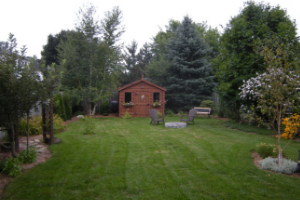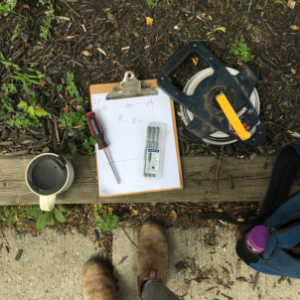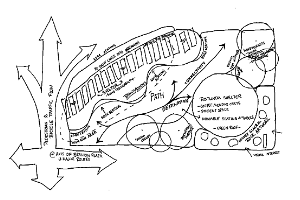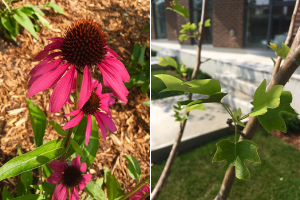This will require thinking about environmental conditions, function, aesthetic and more. If you’re ready to don your designer hat and flex your observation skills, follow the simple steps below and watch how your garden practically designs itself!

Yard Map
- Grab a sheet of paper and your favourite writing utensil and sketch a basic outline of the shape of your yard. It can be a rough approximation or more accurate by using a measuring tape.

Inventory
- Mark on your sketch where major features of your property are located (house, patio, fence etc.) – this doesn’t have to be fancy, just a simple arrow or label will do!
- Since most yards aren’t a blank slate, note what plants are doing well and that you’d like to keep. Draw in where they are approximately located in your yard using a symbol like a circle.
- Mark existing trees on your sketch so you remember to give them space in your yard when you’re planning your design. You can always refer our spacing requirements for a guideline of how much space mature trees and shrubs need.
Yard Conditions
- Understanding your yard’s environmental conditions is an essential step in knowing what plants will do well in your yard – note on your sketch which areas receive sun or shade, and keep your soil type information handy by jotting it down in the margin of your page.
- Identify your plant hardiness zone to help you determine what can grow naturally in your neighbourhood’s climate.
Opportunities and Constraints
- Consider what might be the limitations of your space. How can you work around these with creative, space-appropriate ideas? Is there limited space in your small yard? Or, is it very shady?
- Consider what in your garden presents itself as an opportunity. Is there a lovely feature you want to highlight? Or, is there a sunny spot that is the perfect location for a pollinator garden?

Function
- Consider how you want your space to function. Thinking about the purpose of your garden will help you hone your design ideas. Is it meant to be an outdoor oasis? Or, is it a naturalized space, great for Backyard Biodiversity?
- Mark where you’d like these functions to take place on your sketch. Is it a new seating area under the shade of your tree? Or, is it a planting bed that attracts birds by your back window?

Plant Selection
- Drawing on what you know about your yard’s climate and soil conditions and desired function, you can begin to select plants that will suit your space and your personal preferences.
- By referring to a native planting guide for Southern Ontario you can check to ensure all the species you choose are native to your area and will support local biodiversity.
- Selecting a theme or a colour scheme for your yard may help you narrow down your plant choices and develop a design aesthetic. Mark on your sketch where your new plants will be placed in your yard – or better yet, cut out some coloured circles that represent your chosen plants and play with different arrangements on your sketch.
With these simple steps, you can continue the rewarding process of getting to know the microhabitat of your yard all while engaging in place-based landscape design. But, if you need help assessing your yard, selecting tree and shrub species and deciding on their placement, our Backyard Tree Planting Program will be able to help you! Participating in this subsidized planting program gives you access to a consultation with a certified arborist, a selection of native trees and shrubs to choose from and delivery or planting by LEAF. Visit www.yourleaf.org for info on our programs!
Kaja McDonald is the Stewardship Assistant at LEAF. Kaja holds a Masters in Landscape Architecture from the University of Guelph.
This blog is the conclusion of a three-part blog series:
Planting the Right Tree in the Right Place
LEAF offers a subsidized Backyard Tree Planting Program for private property. The program is supported by The City of Toronto, The Regional Municipality of York, The City of Markham, The Town of Newmarket, The Town of Ajax, Ontario Power Generation and Toronto Hydro. For details on how you can participate, visit http://yourleaf.org.
